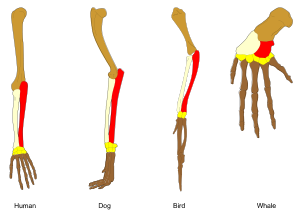
Back Homolochía (biolochía) AN تنادد Arabic Хомология (биология) Bulgarian সমসংস্থা (জীববিজ্ঞান) Bengali/Bangla Homologija (biologija) BS Homologia (biologia) Catalan Homologie (biologie) Czech Homologi (biologi) Danish Homologie (Biologie) German Homologio (biologio) Esperanto

In biology, homology is similarity due to shared ancestry between a pair of structures or genes in different taxa. A common example of homologous structures is the forelimbs of vertebrates, where the wings of bats and birds, the arms of primates, the front flippers of whales, and the forelegs of four-legged vertebrates like dogs and crocodiles are all derived from the same ancestral tetrapod structure. Evolutionary biology explains homologous structures adapted to different purposes as the result of descent with modification from a common ancestor. The term was first applied to biology in a non-evolutionary context by the anatomist Richard Owen in 1843. Homology was later explained by Charles Darwin's theory of evolution in 1859, but had been observed before this, from Aristotle onwards, and it was explicitly analysed by Pierre Belon in 1555.
In developmental biology, organs that developed in the embryo in the same manner and from similar origins, such as from matching primordia in successive segments of the same animal, are serially homologous. Examples include the legs of a centipede, the maxillary palp and labial palp of an insect, and the spinous processes of successive vertebrae in a vertebral column. Male and female reproductive organs are homologous if they develop from the same embryonic tissue, as do the ovaries and testicles of mammals including humans. [citation needed]
Sequence homology between protein or DNA sequences is similarly defined in terms of shared ancestry. Two segments of DNA can have shared ancestry because of either a speciation event (orthologs) or a duplication event (paralogs). Homology among proteins or DNA is inferred from their sequence similarity. Significant similarity is strong evidence that two sequences are related by divergent evolution from a common ancestor. Alignments of multiple sequences are used to discover the homologous regions.
Homology remains controversial in animal behaviour, but there is suggestive evidence that, for example, dominance hierarchies are homologous across the primates.
© MMXXIII Rich X Search. We shall prevail. All rights reserved. Rich X Search